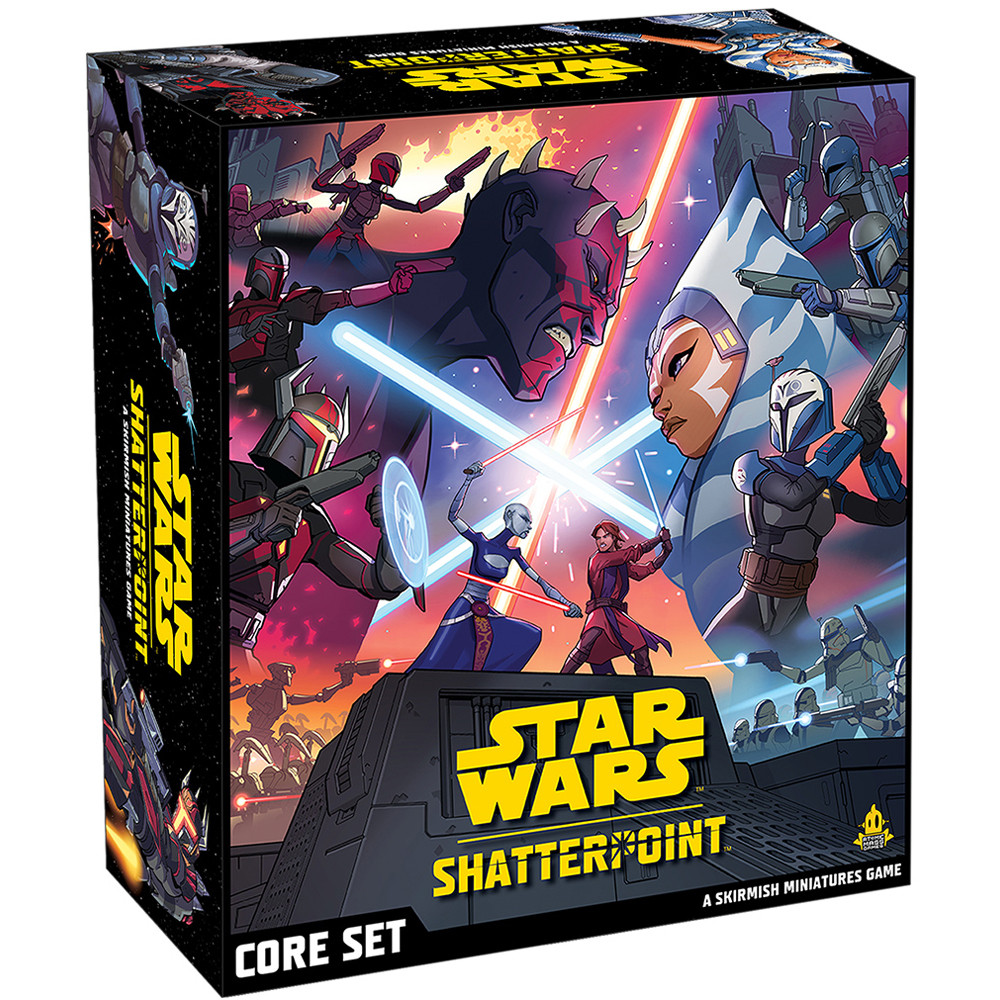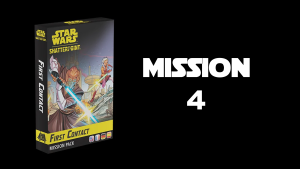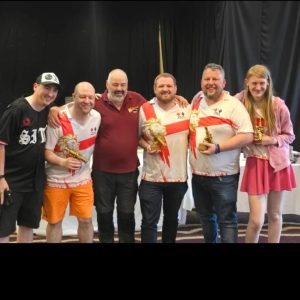I took my time to get a thorough feel for it as well as a competitive tournament under my belt, but I’m finally ready to give The Fifth Trooper’s formal review of the newest Star Wars minis game.
It’s been the better part of a year since we first discovered that Atomic Mass had been working on a brand new line, one that we immediately (mostly incorrectly it turns out) labelled “Star Wars MCP.” I randomly volunteered to write a reaction article to the announcement, where I openly wondered what it meant for Legion. As the months past and the information slowly dripped in we mostly stood back and allowed the news to percolate around here, stopping briefly to take some guesses as to the meaning of the attack chart and then having a bit of fun at your expense on April Fool’s day. The truth though, was that even after our first impressions playing the game at Adepticon we knew so little about how this would feel that we could really only guess.
Fast forward to now, I’ve got my main strike team painted and working on many more, I’ve learned the games rules thoroughly (after much trial and error) and finally was able to get a day of competitive play under my belt, which I felt was necessary to write the review people wanted to read. Those of you with twitchy fingers may want to skip to the good stuff, and I won’t even make you scroll: Star Wars Shatterpoint is a dynamic and challenging game with beautiful models that rewards a player’s tactical decision making above all else, and it easily earns its place among the current crop of Star Wars minis brands. If you’d like to know why, then I’d love for you to stick around!
How would one describe this game in three sentences?
For an actual dip into the rules of Shatterpoint you can check out this article by RHeniz, but I’m going to give the super-fast pitch for it right here, right now:
Shatterpoint is a game where each player fields two heroes along with their small posse (that can be from all over the place alignment-wise as long as the share an era) who activate (mostly) randomly and earn points by outnumbering their opponents near rotating objective markers, which builds up toward winning a tug-of-war like “struggle” between you and your opponent. Just like in tug of war your goal is to pull a rope across your line, but here you can earn the chance to move your “line” closer to the center as time goes on. If the “rope” crosses your line you win the “struggle,” but this usually means your opponent will have an advantage on the next struggle, and the first person to win two total struggles wins the game.
Something Old, Sort Of…
Since the readers on this site are more likely than most to at least be aware of a wide variety of games games I feel it’s useful to illustrate how Shatterpoint borrowed elements from multiple predecessors to create a lovely pastiche that, as a whole, represents something that feels new.
- Shatterpoint has the “attack results” flowcharts of Arena Rex and Guild Ball but with significantly more player choice and options. Basically, if you roll 4 hits on offense and your opponent rolls one block on defense, then you don’t just do “3 damage” but rather get to move 3 spots up on the combat tree. So, in the example below, Maul could basically do 10 damage and shove his opponent twice or 7 damage and shove his opponent THREE times. Damage and Shove are two comon examples of effects but these also include status effects, jumps, healing, abilities, and full movements. This makes “fighting” itself very dynamic, one good roll can have half a dozen different effects.


Arena Rex’s flowcharts were an innovation for that game, Shatterpoint’s evolution of it is by comparison actually a fair bit more dynamic
- It has a default set of action choices that’s similar to our beloved Star Wars: Legion, (minus standbys) but when where recover actions are basically “Treat: One” instead of what we are used to them doing. Also, dodge actions both give you the silly sounding but extremely useful “Hunker” tokens (which you need to get cover at all, ever) and let you move your character slightly as well!
- The game plays somewhat like Marvel: Crisis Protocol (MCP) if it was only “Secures” but it’s now fair to say that early assumptions that Shatterpoint would be anything close to a “Star Wars MCP Clone” were actually quite a ways off. The minis count per game is substantially higher than most MCP matches (16 total minis on the board for Shatterpoint versus usually around 9 for MCP) and there is significantly more movement that happens per activation in Shatterpoint as well. Characters in Shatterpoint share a resource for abilities that cost resources instead of each character having their own supply as in MCP, and everyone in Shatterpoint has an an active or reactive ability that’s free (at least while that character is un-hurt) and is usually very significant. Finally, these games certainly share a similar aesthetic when it comes to the cards and the minis themselves, but the board itself usually looks quite different.
- The “tug of war” style scoring system somewhat reminiscent of connoisseur-style (I haven’t played them mind you so I ain’t braggin’, they just seem high-brow and complicated!) European board games like Twilight Struggle and Churchill but is a fresh concept in miniatures. This system also implements significant but not-insurmountable “rubber-banding,” to make it harder for a player who is winning to pile on. That said, the winner of the first struggle definitely has a big advantage, so don’t worry that this is the minis version of a blue tortoise-shell.
…But Mostly New
Just as a mixed paint may look nothing like its ingredients, Shatterpoint travels well beyond this array of influences to yield a game that feels truly “fresh.” Since I’m human and often simple-minded, I’ll freely admit that I did come into this game expecting what was mostly a “DLC” pack for Crisis Protocol, but as time went on and I shed my initial biases I found myself enjoying the game more and more. I’ve never played anything quite like it and I’d like to get into a few of the key reasons why this is so.
Fighting is about Maiming, Not Killing
The most miniatures that I’ve seen actually get removed from the board, during a complete game of Shatterpoint, is two. When I attended a competitive tournament where the flow of the game is sometimes a bit accelerated by the nature of the floor rules (more later), not a single character in my games was picked up before it was over. Everyone in this game has at least two “lives” and most of the primary characters have three. Not only that, but even when you reach the wound threshold of any life a character won’t leave the battlefield until after they get one last “death” activation, no matter what. “That seems kind of silly” I thought at first, “how do you keep things interesting if neither player is very capable of affecting the balance of offensive power and activations?

A lovely tray of minis. This and all other photos aside from the box are from the tournament I went to (see below)
Well, here’s how:
- Wounded (meaning, they have enough wounds to meet their threshold) characters don’t contest objectives or engage characters in melee, and move on to the next “life” until they activate again, which can be quite a while in this game. While they wait to do so, they can still use abilities and move around the field using reactions which ends up being kinda huge.
- After they recover from their wounds on their next activation, they need to pay more for their abilities for the rest of the game, which can be crippling for some abilities which could go from draining a third of your force pool all the way to a majority of your pool in the worst case
So, even though I didn’t see a single model taken off the table in three tournament games this isn’t to say “nothing happened.” Quite the opposite, when wounds did occur they were always meaningful, but unlike most games they weren’t paired with the usual “snowball” effect of attrition. If your Anakin meets his wound threshold in Legion then you’re probably not gonna do well in the rest of that game, by comparison an Anakin who gets wounded in Shatterpoint will be less efficient but still extremely useful on the board. When I first overheard that primary characters in this game almost never “die” my first thought was how boring this sounded, but in truth it allows the game to be dynamic while still allowing players to “bounce back” and importantly it reduces that icky feeling you get picking up your model and setting it aside for half the game.
The Third Dimension
Yes, obviously Legion is three-dimensional, but in Shatterpoint the concept of height is much more palpable. Rather than just being a way to get cover or protection from melee units, height has a significant effect on the dynamics of how characters move and how they can move each other in Shatterpoint. If a battle droid is pushed into a building from an attack they will stop there, but if they are pushed off a building or walkway then they will fall to the ground and slide the full horizontal distance as well (they don’t take falling damage though, which is probably good for balance). Additionally, while you can contest an objective at a different height from the actual objective token, a character at the same height will always have the priority in determining control. In other words, a single battle droid model would “control” a point he’s chilling with alone on a gantry even when there’s any number of characters directly below him. When you put these things together with the substantial amount of terrain included with the core set and easy options to expand from there, you get a game that squeezes more out of that third dimension than any other I’ve played before.

A Mando Fracas
Vital Assets
Which brings me to the last notch to the game’s uniqueness that I’d like to highlight: the core set.

While it’s obviously true that $150 nothing to sneeze at, I feel pretty comfortable in saying that this core set provides more value than any game I’ve seen before. There’s a lot going on in the image above but I’m not silly enough to suggest that the game should get extra credit for having a bunch of templates and tokens that are necessary to play the game, that’s baked in to any Core Set. Instead I’d like to point to two things:
- There are 16 figures representing 12 “units” (because the grunt units typically have two bases for one unit) in this box. That is, in fact, enough for two people to play an actual fully-fledged game against each other. It’s been said many many times so I won’t gush too too much but…these models are also quite detailed and easy to assemble. They’re fantastic.
- It contains a very good foundation for this game’s highly modular terrain pieces (all that terrain above is in the box), enough for the kitchen table for sure and nearly enough for a competitive game.
For some context compared to the other games I’ve played in the last decade…
- Legion: 4 units each for two factions, less than half what you’ll need for a full game
- X-Wing: Four rebel ships or four empire ships, almost but not usually quite a full tournament ready list for one person. “Terrain” is flat cardboard obstacles, it’s a 2-D game.
- Armada: Variable depending on what faction you want but either a good foundation for one person’s list (Clone Wars) or a bad foundation for two lists (original Reb v. Empire set). “Terrain” is flat cardboard obstacles, it’s also a 2-D game…and the cores don’t even have space whales you have to buy an extra set for those!
- Marvel Crisis Protocol: 10 characters that are heavy Avengers and mildly Spider-Man focused, and some terrain as well. There will be a new core set coming out with new variations of all these characters and will also have more in the terrain department. However, to play a “full” game where each player is supposed to have 10 characters to choose from, this will only technically allow one person to field a complete team just from the core. Still, it’s a very good value, assuming that you like any of the characters in the set (which I don’t, mutants only for me!)…but still not as good as Shatterpoint.
When I went to a Shatterpoint tournament at Magic Stronghold in Vancouver, BC, Canada there was an entire family of four there who were all playing at once, one of them told me they were able to do that from just two core sets. If that ain’t a beautiful thing, I don’t know what is.
“But is it competitive?!”
By now, I have developed bad taste for this phrase, but I’m not going to pretend that I don’t know what people mean when they ask it. Well, at least, what I think they mean…which is really the following:
“How important is a player’s skill in determining the outcome of a game?”
Well, it may come as a surprise to you when I say that while it is too early to say this for sure, I believe it’s possible this is the most skill-determinant minis game that AMG or FFG have released to date.
No Easy Buckets
Legion players will be familiar with the concept of activations that…don’t matter that much. In Key Positions that might be half of the activations you play that game! But more commonly, think of when you pull a Special Forces token and it’s time to activate one of your snipers. It’s…possible, that the decision to say do a “move, shoot” rather than an “aim, shoot” with them may actually be a swing point for determining the outcome of a game…but probably not. The same goes for any list that has naked corps taking up space, you’re gonna take a lot of activations where what you do doesn’t REALLY matter that much, so your important decisions are concentrated into your more powerful units.
Well, not in Shatterpoint. This is a game where the score changes (nearly) every activation, and one wrong decision can cause things to crumble extremely quickly. One thing that may surprise some of you is that each character may only activate twice or even once if the game is particularly short. As a brief reminder, your deck consists of 7 cards: your 6 units and a Shatterpoint card which is basically a wild card so you can activate whoever you want. You will reshuffle this thing once, maybe twice, before a typical game is over…but then? It’s over. If you pull a power card early you can pay a Force to put it in reserve so you can have control over someone you really want control of, but there’s no guarantee it will really work to your favor to do that. This can lead to a negative play experience when your favorite character only gets to attack once the whole game. Still, this isn’t near the type of NPE one gets when in either Legion or MCP your favorite guy gets last-firsted to hell by your opponent’s most powerful attack before you even get to do anything. Even of you only get two chances to activate your favorite character, at least you’ll feel secure that it’s impossible for them to be wiped out by the enemy before they get a chance to do anything.

So what does this all add up to? There are few activations, and you have little control over what order they show up in…which means: every activation counts, a lot. The decision to spend a force to jump, to attack with one stance instead of another, to make the effort to get onto elevation: these things matter immensely because if you’re only going to get 15 or so activations for the whole game then you need to squeeze every bit of juice you can out of each one. That’s easier said than done though: in a game where the attack results can mean anything from a huge pile of damage all the way to taking almost no damage but shoving an opponent a third of the way across the map, and where your decisions on reserving activation cards can make or break a struggle, there are an insane amount of variables one can consider with each decision. It can be very overwhelming! In this early point of the game’s lifespan I think most folks are still getting used to it, but I think the difference between those who really know what decision is best at any given time and those who don’t yet (like me) is going to get wider and wider as time goes on.
The Tournament Experience
As an example, my first game at the Magic Stronghold was against one Matt Bronson, who has been an early adopter and strategist for this game from a competitive standpoint. Matt is an excellent Legion in his own right but in Shatterpoint it was a whole other level from my own amateurish play. He knew exactly what to do with each trigger, and positioned all his characters in exactly the right way to control points and hang onto them. Our game was over in 45 minutes, it was big ouch, but it showed me what’s out there for people who want to find the deeper levels of tactics in this game. This isn’t the place to regale you with a full battle report, but suffice to say I had an excellent time at my first Shatterpoint tournament.

That’s Matt’s Obi on the right against my Obi and Rex. It may look like he was being cornered, but it was really me!
I was able to submarine my way to 2-1 but this was only after a very tight second game which came down to this game’s somewhat unique system of speeding things up in a tournament setting. Long story short, when there is half an hour left the score tracker “moves” more quickly which forces an outcome. We ended up being tied when time was called, and while I won I didn’t feel great about it because I feel like the tie-breaker (# of points controlled when time is called, regardless of current score) rewards something different than what matters all the rest of the game, but my opinion is an early one and it may get changed in the future. I was trying to keep an ear out and I can say most games didn’t go to full time however. When I began playing Shatterpoint for the first time games were 3 hours long, but in a tournament setting where everyone knew that they were doing and the clock had extra scoring implications the games were on average 90 minutes. We ended the tournament after three games, which meant that it was all over in about six hours which included a short lunch break. For someone like me who enjoys having some time for other stuff on a tournament day, I’m not one to complain.
A New Hope?
It is, of course, still very early. One commonly noted question mark is that while we’ve gotten several expansions since the Core release already, we still only have one set of “battle cards” that determine how the points are scored and how they shift between rounds. This fact has not, as I originally worried, made the game feel stale already because even this fairly simple core set of battle cards allows for very interesting game situations. This is because the dynamic nature of the game and the fast pace of releases these first few months (AMG has acknowledged it will slow down) has kept things fresh, but only time will tell how long these good feeling will last without a bit more variety in the gameplay department. The rules are also surprisingly complex and there are a lot of triggers to keep track of. I do think that the game has more casual appeal than most of AMG’s other lines, but competitively players should not take that as an open invitation to figure it out with zero issues.
It’s important that we’re able to own up to and recognize our own biases and believe me, I had a bias against this game when it was first announced that lasted until my first actual game with the full product. I considered myself (and still do) a Legion player most of all, and I was concerned that the attention this game required would take away from Legion as a product. And you know what? It still may have, it will likely be impossible to know for sure. That, however, is irrelevant to the quality of the game itself. What is relevant is that this game managed to break through that muck in my mind to prove to me how solid the product is. But there’s one thing I’d like to close on, maybe the most important one which is that…
This game feels like Star Wars
It’s when you consider everything I mentioned above that things should hopefully fall into focus for you. This is a game that features highly detailed models that toss each other off platforms, move all over the battlefield, and turn the tide of battle back and forth over and over again. I’ve seen it already a few times myself: this games turns HEADS in a game store. The lead developers essentially stated that the Dave Filoni-era cartoon shows were the main inspiration and in that respect I think they nailed it right on the head. While it’s true that it won’t feature any vehicles or grand armies, in truth this isn’t what most casual folks would say lies at the essence of Star Wars anyway. This is not to denigrate the other games, but rather to say that Shatterpoint has truly found a niche that was not well explored. In doing so, I’d say the first chapter of this game has been a resounding success.

I almost, but obviously not quite, made it all the way through a review about a “very vertical game” without a “High Ground” joke
So What’s Next For The Fifth Trooper and Shatterpoint?
Most of you probably weren’t even “counting” on this review but regardless, thank you for your patience! I wanted to ensure I had a dozen or so games under my belt plus a tournament experience so that I could give our readers as complete an impression as possible. Speaking personally, I still consider myself primarily a Legion player, but I have absolutely been keeping pace with the new releases (for Republic anyway) and plan to do so for at least the rest of the year. I’d like to thank Izzy Gambliel and Paul Vogl for helping me wade through my first few games and sharing their thoughts with me as we did so.
I’d like to end with a nice little surprise for everyone though! We’re adding Matt Bronson aka “ZeusJus,” the very same dude who cleaned my clock in my very first competitive Shatterpoint game, to our little crew here at The Fifth Trooper. And as a bonus, we’ve imported every single one of his articles from his own blog to ours, which you can find on our Shatterpoint index here. If you ask me, Matt is the authority on this game at a competitive level, and he’ll be the focal point of our written Shatterpoint content with your truly probably piling in to write my usual silly garbage as well.
To celebrate the addition of bombad tactics to The Fifth Trooper family, we are giving away a Shatterpoint core set and a “You Cannot Run” duel pack to 2 lucky Patreon subscribers! If you are new to the Patreon, you get exclusive access to the Fifth Trooper discord servers and in addition, we have rewards and Patreon exclusive content, We’re really stoked we could add him to the team! Thanks again for reading, let us know how YOU feel about the game on the comments below!





